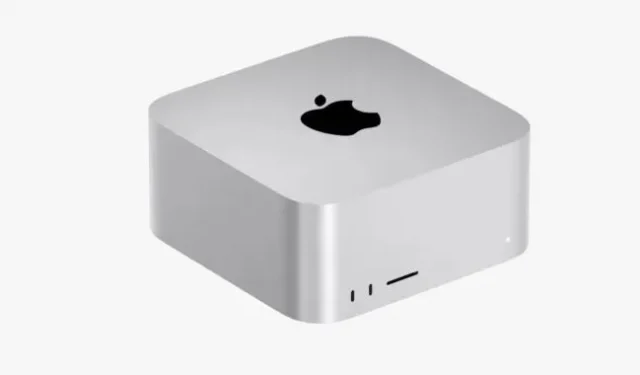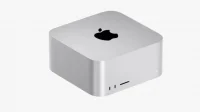For months, everyone has been speculating that Apple will soon update high-end Intel-based Mac mini configurations with its own custom-designed silicon, and now Apple has announced just that at its spring event. But what we got is actually a little more than what we expected.
The new desktop Mac is called Mac Studio, and it’s similar to the Mac mini, but bigger – bigger and more powerful. The thicker desktop comes in multiple configurations based on the Apple M1 Max processor and the new M1 Ultra processor, which doubles the number of CPU and GPU cores compared to the M1 Max.
The more powerful chips allow Studio to offer a vastly improved set of ports over the M1 Mac mini. On the back, you get four Thunderbolt 4 ports, a 10GB Ethernet port, two USB-A ports, HDMI, and a headphone jack. These ports allow you to connect up to four Apple 6K ProDisplay XDRs simultaneously, plus a 4K display using the HDMI port.
Another nice addition: unlike any other Mac desktop computer released by Apple in recent history, the Studio offers two easily accessible USB-C ports on the front, as well as an SDXC card reader that will be handy for photographers.
Mac Studio starts at $1,999, giving you an M1 Max chip with 24 GPU cores, 32GB of memory, and a 512GB SSD. The M1 Ultra configuration starts at $3,999 and comes with 48 GPU cores, 64GB of RAM, and a 1TB SSD. Both will be available for pre-order today, with shipments starting March 18.
The Studio is also featured with Apple’s new original display, the $1,599 Studio Display 5K. We have more details on this in a separate post.
M1 Ultra: two M1 Max chips connected together
The M1 Ultra is a new design that uses “UltraFusion”technology to fuse two M1 Max chips together, resulting in a huge processor with 16 high-performance CPU cores, 4 efficient cores, 48- or 64-core integrated GPU, and support for up to 128 GB of RAM.
It’s entirely possible that Apple is taking a chiplet approach to the M1 Ultra, something along the lines of what AMD does for many of its Ryzen chips. The chiplet-based approach, as we’ve already written, uses multiple silicon dies to make larger chips and can result in higher yields because you don’t have to throw away an entire monolithic 20-core chip if a couple of cores have defects that interfere with them. work.
Like other M1 chips, the M1 Ultra is manufactured using TSMC’s 5nm process. If you want to know the other key specs of the chip, just double everything Apple does in the M1 Max – that means up to 800GB/s of memory bandwidth and a 32-core neural engine.
Apple hasn’t been shy about comparing the Studio’s performance to the Intel-based Mac Pro and 27-inch iMacs it still sells: it says the M1 Max’s processor is “up to 2.5x faster”than the 10-core Core i9 iMac and up to 50 percent faster than a 16-core Mac Pro. Its GPU performance is also reported to be 3.4 times faster than iMac’s Radeon Pro 5700XT GPU. The M1 Ultra performs even better: 3.8 times faster than the best 27-inch iMac and 90 percent faster than the 16-core Mac Pro.
The studio outperforms the more core-count versions of the 2018 Intel Mac mini that Apple continues to (!) sell as of this writing. Although it hasn’t been updated in over three years, the 2018 mini offers more USB and Thunderbolt ports, more external display outputs, and more RAM than the standard Mac mini’s regular M1 chip. The M1 Max and Ultra allow the studio to address all of these shortcomings while taking advantage of the performance and energy efficiency of Apple’s Silicon chips.
This isn’t the first time in Apple’s modern history that it has attempted a compact workstation—the 2013 Power Mac G4 Cube and Mac Pro come to mind, though both products were unfortunate in their own way. But typically, for most of the 2000s, there was a big performance gap between the tiny Mac mini and the hulking towers of the Power Mac and Mac Pro, which Apple mostly tried to fill with the iMac and iMac Pro. As a computer more powerful than a standard mini PC and a lot cheaper than even the cheapest Mac Pro, the $2,000 Studio in particular fills out the “more economical screenless workstation”in Apple’s lineup that the company has.. mostly content to be ignored.


